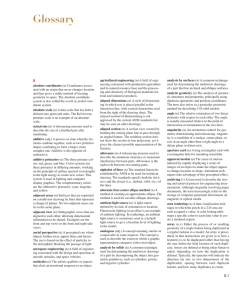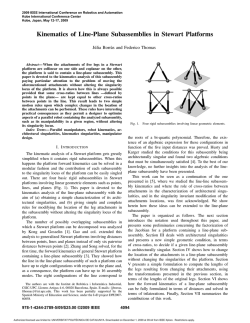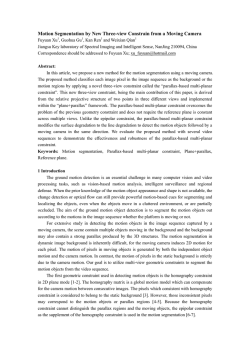
Solutions
CMSC5724: Exercise List 3 Problem 1. Let P be a set of 4 points: A = (1, 2), B = (2, 1), C = (0, 1) and D = (1, 0) where A, B have color red, while C, D have color blue. We want to find a plane that separates the red points from the blue points. 1. Convert the problem to R3 so that it can be solved by the Perceptron algorithm. Give the resulting dataset P ′ . 2. Execute Perceptron on P ′ . Give the equation of the plane that is maintained by the algorithm at the end of each iteration. 3. Convert the plane output by Perceptron back to the original 2d space to obtain a separation plane on P . Answer. 1. P ′ includes the following points: A′ = (1, 2, 1), B ′ = (2, 1, 1), C ′ = (0, 1, 1), D ′ = (1, 0, 1). 2. Let us represent the plane maintained by Perceptron as c1 x1 + c2 x2 + c3 x3 = 0. Denote by ~c = [c1 , c2 , c3 ]. At the beginning of Perceptron, ~c = [0, 0, 0]. ~ ′ to denote the vector [1, 2, 1], obtained by listing the coordinates of A′ . Define We use A ′ ′ ~ ~ ~ B , C , D ′ similarly. ~ ′ does not satisfy A ~ ′ · ~c > 0, we update ~c to ~c + A ~ ′ = [0, 0, 0] + [1, 2, 1] = Iteration 1. Since A [1, 2, 1]. ~ ′ does not satisfy C ~ ′ · ~c < 0, we update ~c to ~c − C ~ ′ = [1, 2, 1] − [0, 1, 1] = Iteration 2. Since C [1, 1, 0]. ~ ′ does not satisfy C ~ ′ · ~c < 0, we update ~c to ~c − C ~ ′ = [1, 1, 0] − [0, 1, 1] = Iteration 3. Since C [1, 0, −1]. ~ ′ does not satisfy A ~ ′ ·~c > 0, we update ~c to ~c + A ~ ′ = [1, 0, −1] + [1, 2, 1] = Iteration 4. Since A [2, 2, 0]. ~ ′ does not satisfy C ~ ′ · ~c < 0, we update ~c to ~c − C ~ ′ = [2, 2, 0] − [0, 1, 1] = Iteration 5. Since C [2, 1, −1]. ~ ′ does not satisfy C ~ ′ ·~c < 0, we update ~c to ~c − C ~ ′ = [2, 1, −1] − [0, 1, 1] = Iteration 6. Since C [2, 0, −2]. ~ ′ does not satisfy A ~ ′ ·~c > 0, we update ~c to ~c + A ~ ′ = [2, 0, −2] + [1, 2, 1] = Iteration 7. Since A [3, 2, −1]. ~ ′ does not satisfy C ~ ′ ·~c < 0, we update ~c to ~c − C ~ ′ = [3, 2, −1] − [0, 1, 1] = Iteration 8. Since C [3, 1, −2]. 1 ~ ′ does not satisfy D ~ ′ ·~c < 0, we update ~c to ~c − D ~ ′ = [3, 1, −2]−[1, 0, 1] = Iteration 9. Since D [2, 1, −3]. Iteration 10. No more violation. So we have found a separation plane 2x1 + x2 − 3x3 = 0 for P ′ . 3. The corresponding separation plane in the original 2d space is therefore 2x1 + x2 − 3 = 0. Problem 2. Describe how to solve the classification problem in Problem 1 by way of linear programming. Answer. First convert the problem into R3 by creating a dataset P ′ which contains the following points: A′ = (1, 2, 1), B ′ = (2, 1, 1), C ′ = (0, 1, 1), D ′ = (1, 0, 1). In particular, A′ and B ′ are red, whereas C ′ and D ′ are blue. Suppose that there exists a separation plane c1 x1 + c2 x2 + c3 x3 = 0. If (x1 , x2 , x3 ) is a red point in P ′ , we require that it should satisfy c1 x1 + c2 x2 + c3 x3 ≥ c4 . If (x1 , x2 , x3 ) is a blue point in P ′ , we require it should satisfy c1 x1 + c2 x2 + c3 x3 ≤ −c4 . This gives us four inequalities: c1 + 2c2 + c3 ≥ c4 2c1 + c2 + c3 ≥ c4 c2 + c3 ≤ −c4 c1 + c3 ≤ −c4 We want to find c1 , c2 , c3 , c4 such that • all the above inequalities are satisfied • c4 is maximized. This is an instance of LP (with the objective function to maximize c4 ). We check whether the c4 returned by LP is strictly greater than 0. If so, we conclude that the original P is not linearly separable. Otherwise, c1 x1 + c2 x2 + c3 = 0 must be a separation plane for P . See the next exercise for a proof. As a remark, for the above instance, LP will return c4 = ∞. Problem 3. Prove that the reduction from linear classification to linear programming explained on Slide 21 of the notes of Lecture 4 is correct. Proof. We will use the notations on Slide 21. We will prove that P is linear separable if and only if the cd+1 returned by LP is strictly greater than 0. The If-Direction. We claim that in this case c1 x1 + c2 x2 + ... + cd xd = 0 is a separation plane for P . Indeed, if p(x1 , ..., xd ) is red, we know (from the result of LP) that c1 x1 +c2 x2 +...+cd xd ≥ cd+1 > 0. Similarly, if p(x1 , ..., xd ) is blue, we know that c1 x1 + c2 x2 + ... + cd xd ≤ −cd+1 < 0. The Only-If Direction. Since P is linearly separable, there is a plane α1 x1 + α2 x2 + ... + αd xd = 0 such that 2 • if p(x1 , ..., xd ) is red, α1 x1 + α2 x2 + ... + αd xd > 0 • if p(x1 , ..., xd ) is blue, α1 x1 + α2 x2 + ... + αd xd < 0. Define γ = min α1 x1 + α2 x2 + ... + αd xd . p∈P We thus know that γ is strictly greater than 0. It thus follows that • if p(x1 , ..., xd ) is red, α1 x1 + α2 x2 + ... + αd xd ≥ γ • if p(x1 , ..., xd ) is blue, α1 x1 + α2 x2 + ... + αd xd ≤ −γ. Therefore, c1 = α1 , c2 = α2 , ..., cd = αd , cd+1 = γ satisfy all the inequalities on Slide 21. As the LP needs to maximize cd+1 , we thus know that the cd+1 eventually returned by LP must be at least γ > 0. Problem 4. The figure below shows the boundary lines of 5 half-planes. Consider the execution of the linear programming algorithm we discussed in the class on these 5 half-planes. Recall that the algorithm starts by randomly permuting the boundary lines, and assume that the resulting permutation is exactly ℓ1 , ℓ2 , ..., ℓ5 . The algorithm then processes ℓi in the i-th round, for i = 1, ..., 5, and at any moment maintains a point p as the current answer. Explain which point p is at the end of each round, starting from i = 2. ℓ5 ℓ4 ℓ1 ℓ2 ℓ3 Answer. Let H1 , ..., H5 be the half-planes whose boundary lines are ℓ1 , ..., ℓ5 , respectively. At the end of the second round, p is the intersection A of ℓ1 and ℓ2 . At Round 3, the algorithm checks whether p = A satisfies H3 . Since the answer is yes, the algorithm does not change p, and moves on to the next round. In Round 4, p = A is tested against H4 . As p does not fall in H4 , the algorithm computes a new p as the leftmost point on ℓ4 that satisfies all of H1 , ..., H4 . As a result, p is set to B. Finally, the last round processes H5 . As p = B falls in H5 , the algorithm finishes with B as the final answer. 3 ℓ5 ℓ1 B A ℓ2 ℓ3 4 ℓ4
© Copyright 2025

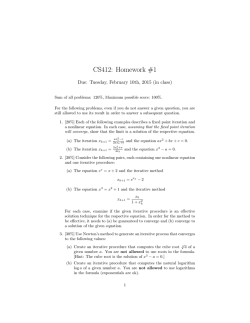
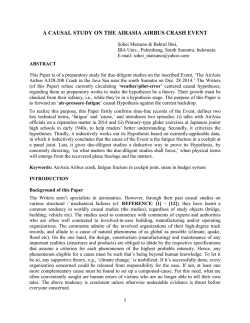
![Flyer on the event [PDF]](http://s2.esdocs.com/store/data/000461133_1-4d88ad04a2122eb11dffd05a58c0a0a8-250x500.png)

